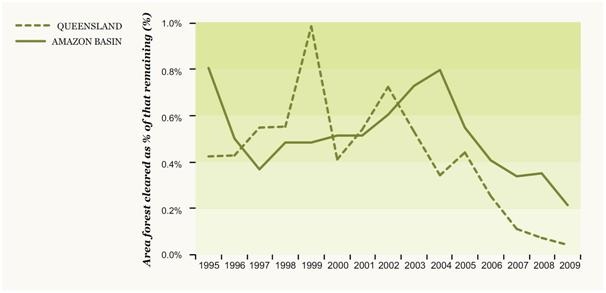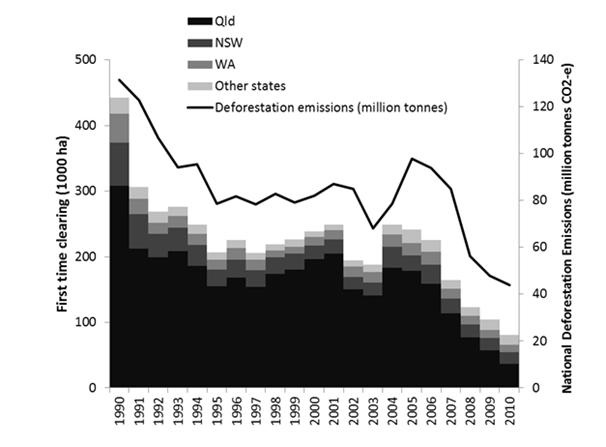Abbott's billion dollar carbon headache
The reverberations from the Newman government’s bulldozing of Queensland’s vegetation protection laws will be felt well beyond the 2 million hectares of native bush now at risk of clearing.
In Canberra right now federal bureaucrats will be doing the maths to work out how this decision will affect Australia’s efforts to cut carbon emissions. Neither side of federal politics will like the answer, but the consequences are most serious for the Coalition’s Direct Action policy.
Up until 2002, land-clearing rates in Queensland were on par with those of Brazil (Figure 1), with an astonishing 300,000 hectares being cleared in some years; the equivalent of one Melbourne Cricket Ground every four minutes. By 2010 the rate of clearing had been reduced significantly, with less than 50,000 hectares cleared annually.

Figure 1: Historic rates of land clearing in Queensland vs the Amazon Basin (Source: Martin Taylor – World Wildlife Fund (2013) Bushland at Risk of Renewed Land Clearing in Queensland)
The huge drop in national land clearing rates between 1990 and 2012 – driven predominantly by Queensland – has reduced Australia’s annual national emissions total by close to75 million tonnes. Without this abatement, Australia’s national emissions would have been around 10 per cent higher than they are today, meaning that we would have significantly overshot our first round Kyoto Protocol target.
The decision in 1997 by the Australian government to count all of the carbon stored in Queensland trees towards our Kyoto target has been the topic of much debate and consternation. Critics were quick to point out that land clearing laws and the choice of 1990 as the baseline, a particularly bad year for land-clearing, gave the federal government a 75 million tonne free kick towards its Kyoto target.

Figure 2: Correlation between annual rates of land clearing and annual emissions from deforestation (Source: Martin Taylor – World Wildlife Fund (2013) Bushland at Risk of Renewed Land Clearing in Queensland and Commonwealth Government (2012) Emission Projections)
Putting aside these old debates, it looks like some of this carbon stored in the Queensland bush is now at risk of being released back into the atmosphere.
In a study released by WWF-Australia last week, it is estimated that the changes in Queensland put at risk carbon stores equivalent to approximately 369 million tonnes of carbon dioxide. This includes 230 million tonnes that is already stored in trees (and up until Tuesday this week was protected under Queensland laws) and another 139 million tonnes that would have been absorbed from the atmosphere from future regrowth.
This does not mean all this carbon is going to be released anytime soon. It merely means it can now be cleared without a permit or for an approved large-scale agricultural clearing purpose which had been banned in 2006.
At a time when we as a nation should be banking old wins and looking for new abatement opportunities (such as transforming our energy sector), we are faced with the prospect of having to deal with a completely avoidable blow-out in emissions in Queensland.
So what are the implications for Australia’s national climate change policy? Well, the answer depends on which policy is in place in Canberra – the carbon price, or direct action.
Under the existing carbon price mechanism, the main headache caused by increased land-clearing in Queensland is that it chews up a significant chunk of Australia’s carbon budget, which means there will be fewer Australian carbon permits for the government to sell to businesses when we shift to a cap-and-trade system in 2015. This means Australian businesses will either need to buy more overseas carbon permits, or make additional investments to reduce their emissions.
Obviously having fewer permits to sell will affect the amount of revenue flowing to the government, but importantly this does not undermine the environmental effectiveness of the carbon price mechanism. Indeed, one of the key strengths of the carbon price mechanism is that it has been intentionally designed to accommodate unanticipated blow-outs in emissions in uncovered sectors. While a blow-out in an uncovered sector may change where the carbon abatement occurs (i.e. overseas or in Australia), the overall national target will still be met.
Crucially important is the fact that having to purchase more international permits does not in any way affect the cost to Australian industry. From 2015 the price businesses pay for an Australian permit will be the same as the price of an international permit.
The headache could be much more severe if Australia shifts to the Direct Action approach to reducing emissions. Under Direct Action, there is a risk that the federal government will need to directly purchase up to an additional 369 million tonnes of carbon abatement as a result of increased land clearing in Queensland.
In reality we don’t know exactly how much of the newly unprotected bush will be cleared, but even if only 20 per cent of it is cleared, the Coalition could be faced with more than a $1 billion blow-out in the cost of Direct Action. This assumes a cost $15 per tonne, which is the same value the Coalition expects to pay for forestry related abatement under direct action.
It is worth noting that the financial risk under the carbon price mechanism is likely to be significantly smaller, because the value of the carbon permits is expected to be lower than $15 per tonne.
The first victims of this rollback will surely be the koalas, wallabies, cockatoos and other native species that call Queensland’s bush home, as well as sustainable agriculture. All up an estimated 163 species of endangered and vulnerable plants and animals will be affected by these new laws, which could see up to 2 million hectares of bush at risk of being bulldozed.
But on the carbon front the Coalition must surely be thinking, has Campbell Newman just given them a billion dollar Direct Action headache?
Dermot O’Gorman is Chief Executive of WWF-Australia.
















